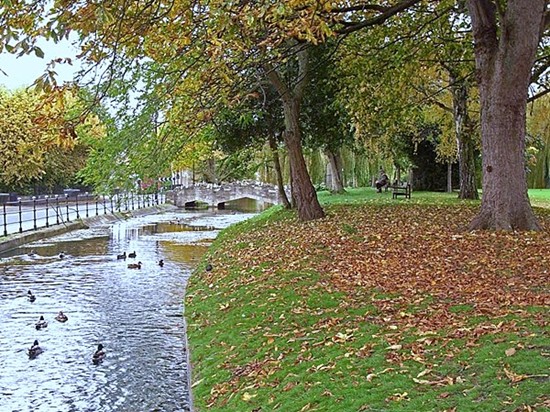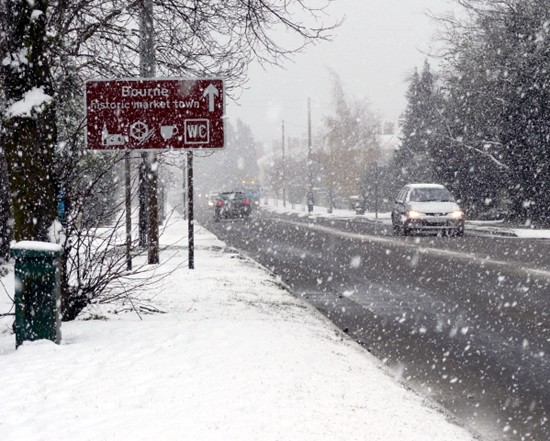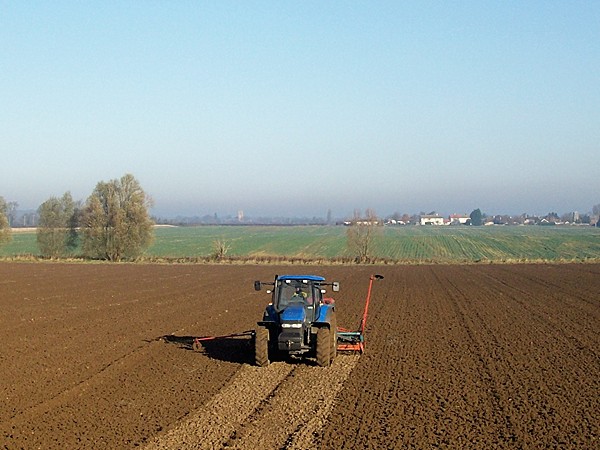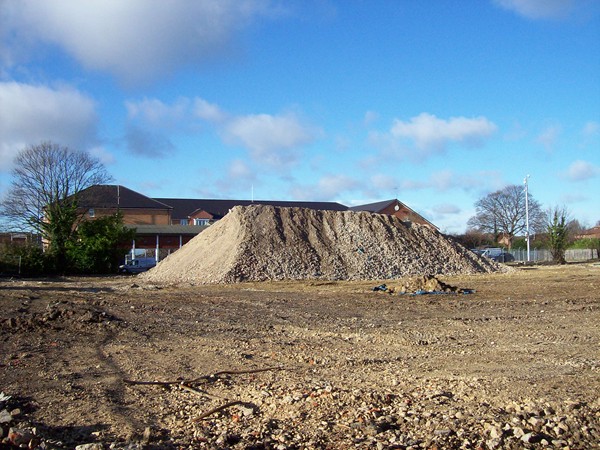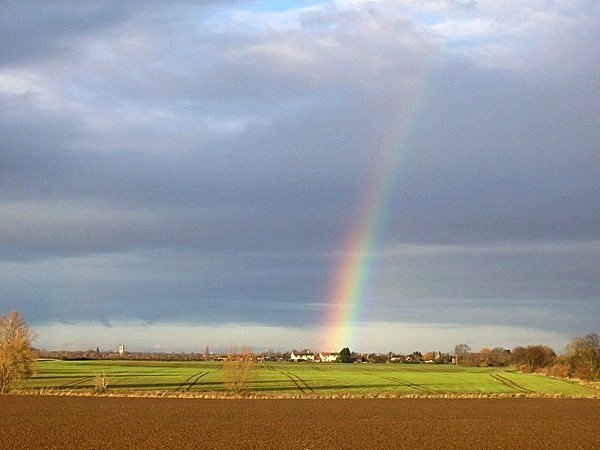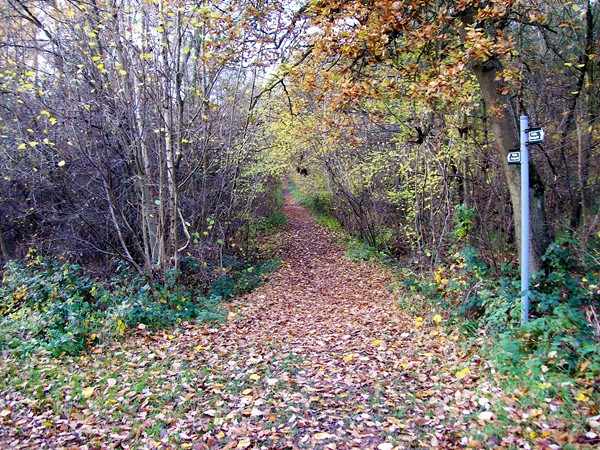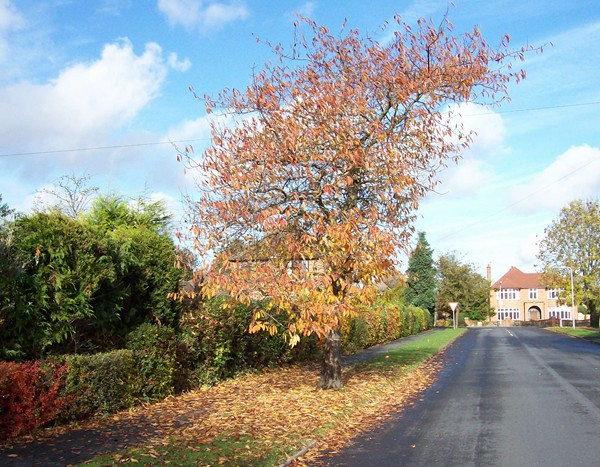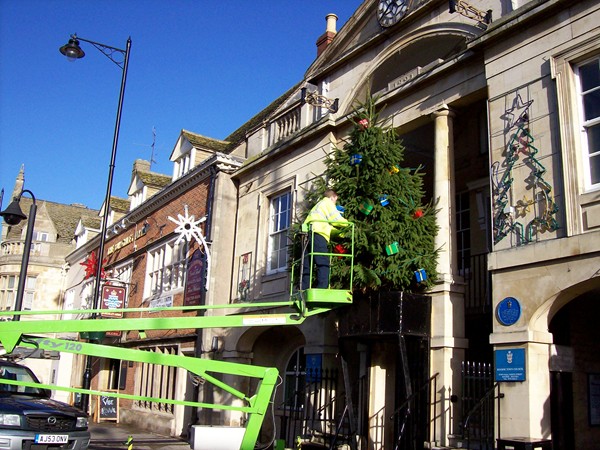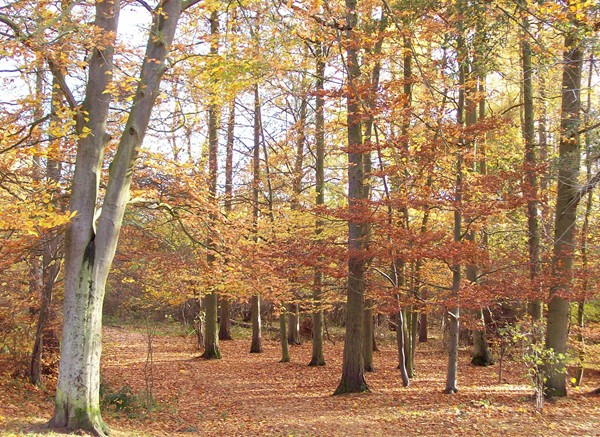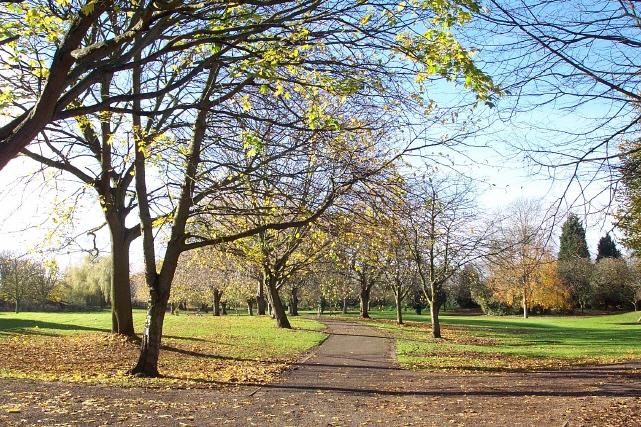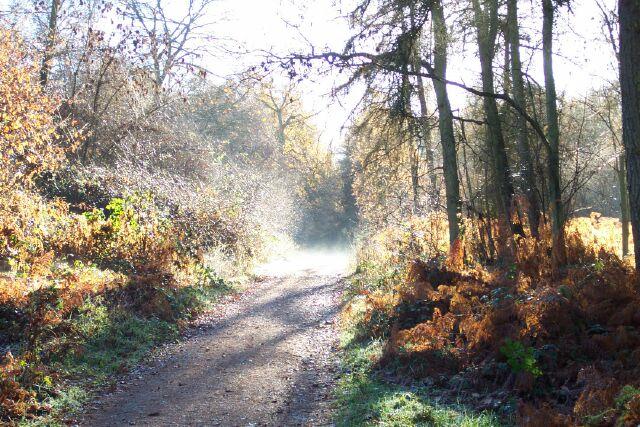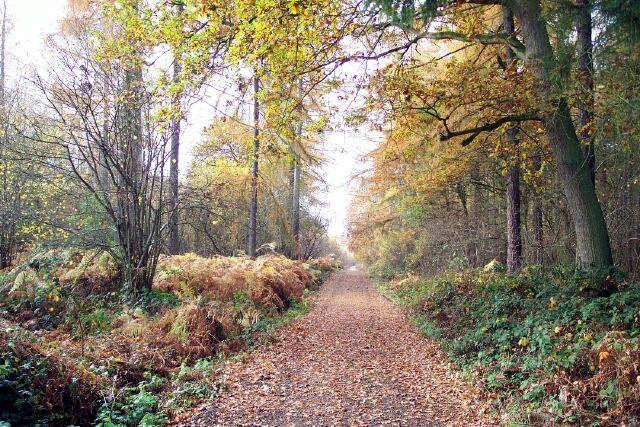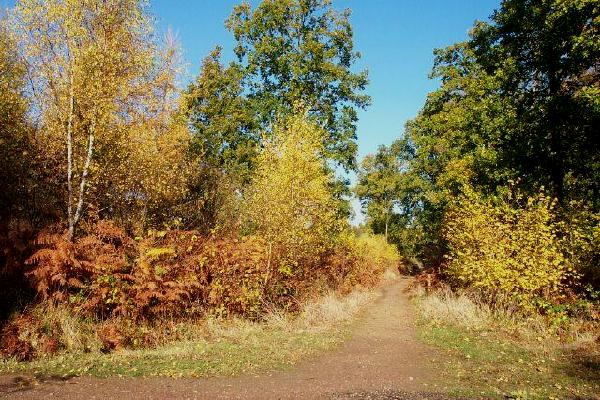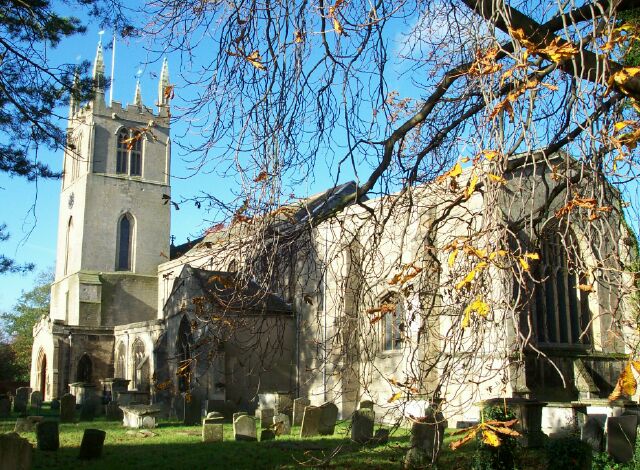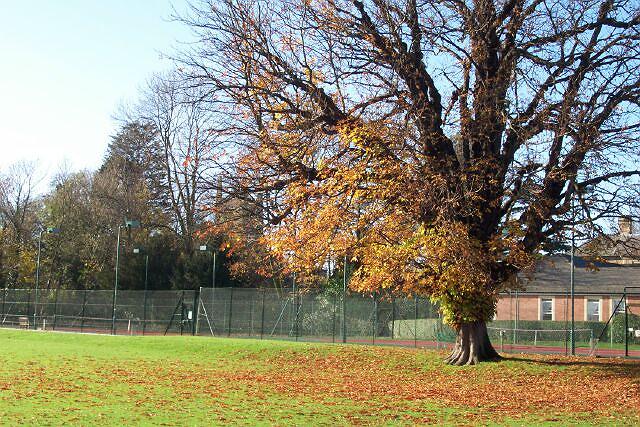|
November
Thursday 1st November 2012: Signs of autumn are everywhere especially where there are trees, such as here in South Street on the banks of the Bourne Eau which runs along the edge of the Wellhead Gardens. The stately line that stands sentinel over the waterway are shedding their leaves and covering the grass with a carpet of golden brown that crunches underfoot and where the birds forage for grubs. This seems to be such a secluded spot and some days it is hard to realise that close by is the A15, one of the country's busiest trunk roads.
Monday 29th November 2010: Winter has come early to Bourne with blizzard conditions and snow-covered roads accompanied by sub-zero temperatures. This has been the coldest November for many years and there are fears that it may indicate worse conditions to come before the year is out. Many old people did not go out for several days, fearing accident and injury on icy pavements, although during the sunny spells children made the most of it by building snowmen and sledging.
Tuesday 16th November 2010: Farming in the countryside is an unending cycle of activity to maintain the continuous production of our food, from spring through to winter, and no sooner has one crop been harvested than another is planted. A few weeks ago this field between the north of Bourne and Dyke village was full of golden corn which has now been combined, the land ploughed and harrowed and now, on a morning of bright but hazy sunshine, it is the turn of the drill to sow winter wheat which will soon become established to withstand the cold weather and so ensure a strong and healthy yield next summer.
Friday 27th November 2009: Our street scene is changing at a greater speed than at any other time in our history as old buildings are pulled down to make way for new commercial and residential projects although housing now constitutes a major part of these developments. Some of the most unlikely places are being cleared of once familiar properties to make way for small estates of one, two and three-bedroom properties, such as here at the old laundry site in Manning Road, which will mean new tenants moving into the town and so we are perhaps witnessing a major population boom.
Monday 24th November 2009: A changing weather pattern over the fens in recent days has brought a magnificent display for those who delight in watching the sky for in this flat landscape you have an uninterrupted view of the horizon. Intermittent rain resulted in a rainbow over Dyke village on a skyline already bathed in autumn sunshine, illuminating the whitewashed cottages in the main street and even the tower of St John the Baptist Church at Morton beyond, but the colourful band which lit up the sky was transitory, staying just a few moments before it was gone.
Tuesday 18 November 2008: Woodland paths have an air of mystery because they beckon the visitor to explore the deeper and less frequented parts of the forest. At this time of the year, they have the added attraction of being strewn with autumn leaves to create a golden carpet that rustles underfoot and also protects against the mud created by recent wet weather and so visitors may complete a long hike along these ways without soiling their shoes.
Friday 7th November 2008: Trees abound on the roadside verges of Bourne especially in those districts which have sprung up in the past half a century as the town expanded at a faster rate than at any time in its history. Queen's Road was built for council housing and well landscaped by an efficient local authority, Bourne Urban District Council, now defunct, and the legacy of those officers responsible can be seen to this day. Autumn brings out the most beautiful colours in our trees, a symphony of brown, gold and red, and those planted to improve the urban landscape are a welcome delight for all who pass by.
Sunday 26th November 2006: It is a sure sign that Christmas is coming when the lights start appearing in public places and this morning we found electricians busy installing and decorating the tree outside the Town Hall. The 15 foot tall fir has been perched between the building’s two famous Doric columns and Trevor Wand, of Town and Country, who is in charge of installing the illuminations, brought along his apprentice to help. Mark Williamson, aged 16, former pupil at Bourne Grammar School and now training for the trade, reached the dizzy heights with the aid of a piece of equipment known as a cherry picker, otherwise a MEWP, the acronym for Motorised Elevated Working Platform, that has a reach of more than 40 feet, quite enough for Mark to put the finishing touches to the tree which will be the centrepiece of the switching on ceremony on Friday evening.
Monday 20th November 2006: Autumn is always a colourful time in Bourne Wood because the varied planting of deciduous trees ensures an attractive mixture of colour when the leaves begin to fall. Gold and brown predominate but here just off one of the main paths about half a mile from the Beech Avenue entrance you will find a small clump of birch that annually produces a delicate palette of deep, rich browns and reds, turning the forest floor into a carpet of exotic shades to remind us that the year is slipping away and the woodland is preparing for its winter hibernation.
Monday 6th November 2006: Shorter days and fewer hours of sunshine herald the onset of autumn but the bonus is that we have a galaxy of russet colours around us as the leaves fall and cover the paths and pavements with a glorious mixture of oranges and yellows, deep reds and rich browns. In the Wellhead Gardens, the avenue of horse chestnuts leading from West Street to St Peter's Pool produces a rich carpet of colours which rustles underfoot as visitors pass. Soon, these golden days of autumn will give way to winter but come next April, the scene will again be transformed as the trees along the avenue burst into life with red blossom, an ever changing scene that reminds us of the inevitability of the passing seasons.
Thursday 17th November 2005: St Peter's Pool is slowly filling up after a summer of low water levels and the waterfowl that live here appear to be far happier with their revived habitat. Visitors often come to feed them and some are here so regularly that mallard and moorhen and even the stately black swans swim over to meet them, anxious to sample the tasty morsels they have brought with them. Among those to be seen here most days are Kevin Lee, who lives not far away in Tennyson Drive, and his 21-month-old daughter Ella, always ready to take her turn in handing out the food with squeals of delight when the friendly flock comes so close and in years to come she will remember with nostalgia the simple pleasure of Dad taking her to the pool to feed the birds.
Thursday 11th November 2004: The colours of autumn can be seen in all of their glory in the Wellhead Gardens, just a short step from the town centre in Bourne. The main path is lined with ornamental cherry trees that have been shedding their leaves for some days, leaving the floor underneath covered with a golden carpet that rustles underfoot as you walk by. Come next April, the scene will again be transformed as the trees along the avenue burst into life with white and pink blossom, an ever changing scene that reminds us of the inevitability of the passing seasons.
Thursday 4th November 2004: The small square of green space to the west of Bourne bordered by Woodland Avenue, Beech Avenue and Forest Avenue, is one of the prettiest in the town, especially in autumn because there are many trees here whose leaves turn a galaxy of brown, red and gold before finally shedding them for the winter. The chestnuts that line the road at this point are particularly attractive, casting lengthening shadows indicating the days are getting shorter and we therefore enjoy less sunshine. The spot was once occupied by the Hereward Labour Camp, later to become a Home Office approved school for young offenders, but the huts were demolished over thirty years ago to make way for the Beech Avenue development although an avenue of Lombardy poplars which formed the entrance has been preserved and some of the surviving brickwork from the foundations can still be found in the grass.
Friday 28th November 2003: Bourne Wood still holds an attraction even on cold days such as this when we stepped out briskly to keep warm. The ground was frozen hard beneath our feet and the path covered in frost although the mid-morning sun was breaking through, casting long shadows through the larches and warming the earth sufficiently to start a slow thaw and creating a white mist that shrouded the way ahead where its rays were the strongest. The trees are always more conspicuous now than in summer, their bare trunks and branches silhouetted against the sky, while the air is filled with the smell of damp undergrowth rising from the forest floor which is covered with a mass of brown and golden bracken mingled with layers of fallen leaves, dead stems and bare twigs. This is the smell I always associate with late autumn and it is also a reminder that winter will soon be upon us, when the woods fall silent as wildlife retreats to its private places until the first signs of spring.
Sunday 23rd November 2003: Christmas is coming and the festive illuminations are being erected in the main streets of Bourne where they will be switched on next weekend. For the first time in five years, a massive tree has been erected outside the Town Hall and on this dull and grey autumn morning I found electricians fixing the lights with members of the local Lions Club on hand to assist with the decorations. The tree was moved away from the town centre in 1998 because of vandalism but the new location in the car park adjoining Budgens' supermarket has proved to be out of sight and out of mind and so the town council has agreed to allow it back this year where it will once again be the central point of the Christmas season, much to the satisfaction of traders and shoppers.
Thursday 13th November 2003: One of the delights of Bourne Wood is the many paths and tracks that cross these 400 acres of ancient forest, leading to secluded glades and private places. They are sunny and open in summer and dark and forbidding in winter but it is always an adventure to walk them and discover new places, never before explored. This is a view of one of the main paths, not far from the Beech Avenue entrance, a well-trodden way that has many trails leading off into the denser areas of the wood where deer and foxes dwell and many species of birds can be found at all times of the year. There are many who only visit Bourne Wood during the warm days of summer but the damp days of autumn also have their appeal.
Saturday 1st November 2003: Autumn this year has been the most colourful in living memory, the result of a dry weather pattern that has brought little rain and no wind, and as our trees prepare to shed their leaves, they have provided a kaleidoscope of glorious colour from yellow and gold through to red and brown. The scene has been accentuated in Bourne Wood where the bracken has provided its own contribution to this seasonal palette of russet shades along the well worn paths. The Forestry Commission who administer the woods in Britain has been monitoring the transformation as part of an "Autumn Colours" campaign, the changing shades of the leaves being rated on a scale of one to five, where one is green and five is gold. Bourne Wood has a wide variety of deciduous trees including beech, birch, oak, maple and hazel, and the spectacular sight they have produced has been given a gold rating in recent days and this is the reason why.
Tuesday 26th November 2002: The last of the autumn is evident here in the churchyard around Bourne Abbey where lengthening shadows and the few leaves that cling to the horse chestnut trees are a sign that winter is just around the corner. The church dedicated to St Peter and St Paul has been a landmark in this place for more than a thousand years and it is hard to imagine that the main road between London and Lincoln ran close by the tower, just a few feet away, but was diverted in later years when it was realised that constant traffic, even from stage coaches and other horse drawn vehicles, might damage the fabric. The church is a difficult building to photograph because it occupies an enclosed location but after five years of perpetual effort, I have decided that the best spot to capture all of its glory is from the extreme south eastern corner of the churchyard soon after midday when the sun is shining which gives the ancient stonework a particular appeal and in November there is the added element of mystery.
Tuesday 19th November 2002: The last of the autumn leaves cling to this ancient horse chestnut tree at the Abbey Lawn in Bourne, a reminder that winter is not far off. The first frosts have already been and gone and recent gales have stripped most trees around the town, leaving a golden carpet on the grass underneath the bare branches. This green open space has been the scene of leisure and recreational activity for centuries and in 1934, it was secured for the town in perpetuity when it was bought by Bourne United Charities as a public amenity while the trees and shrubs were planted the following year to commemorate the Silver Jubilee of King George V and so this magnificent horse chestnut is almost 70 years old. Behind are the tennis courts and through the trees on the left you can see the 12th century tower of the Abbey Church, a symbol of faith in this town for almost a thousand years.
Monday 11th November 2002: High winds in recent weeks have mostly stripped the trees of their autumn leaves and few remain but they line the paths and pavements of many streets in the town, especially here in West Road where there is an abundance of elm, ash and oak. The houses are known as the West Road Villas and were the grandest properties in Bourne during the late 19th century. They were built between 1885 and 1890 on land owned by Robert Mason Mills, founder of Bourne's aerated water business, and it was his idea to erect large and grand houses that could be occupied by leading families in the town who could afford domestic servants and he supervised the design himself. They are therefore, all extremely large with front gables and dormer windows and there was ample accommodation for staff on the top floor and attic rooms, although Mr Mills never lived in one himself and we therefore assume that he built them as an investment. This part of the town still enjoys that appearance of Victorian grandeur and is especially attractive at this time of the year.
Sunday 10th November 2002: It is at this time of the year that we remember our valiant dead, those who gave their lives in the battles of recent years, particularly the two world wars of the 20th century. The cenotaph here in Bourne was erected as the centrepiece of the War Memorial Gardens in September 1956 and bears two plaques containing the names of those from Bourne who never returned, one on the south side listing those who lost their lives in the First World War of 1914-18 while that on the north side contains the names of those who died in the Second World War of 1939-45 and subsequent conflicts such as Malaya, Borneo and Northern Ireland. But it is the poppies that bloomed in the fields of Flanders in that first great conflict that have come to symbolise those we have lost and so they appear every year to commemorate Remembrance Day, in wreaths here at the cenotaph and pinned to the lapels of those who have reason to remember. We live in a changing world and perhaps this annual remembrance to honour our dead may soon disappear and so this is perhaps a time to ponder on the moving lines of Laurence Binyon, known to everyone who has served, from his poem For the Fallen: They
shall grow not old, as we that are left grow old;
Friday 30th November 2001: On a beautiful sunny morning, I found myself down by the river behind Eastgate. The Bourne Eau is joined here by the Car Dyke and a pool has been created at the junction where a pair of swans were grooming themselves, first the cob and then the pen, washing their feathers and splashing about in the water. Mute swans have been breeding in the wild in England for centuries and the first are reputed to have been brought back to this country from Cyprus during the 12th century by King Richard I, better known as Richard the Lionheart, and they were once a luxury food but are now protected by law. They are not quite as silent as their name suggests and they will snort and hiss when annoyed and even make a weak trumpeting sound while their wings could give you a nasty bruise if you got too close. But their white plumage, orange bills and long curved necks present a majestic sight as they glide past on the river and so it was even more exciting to catch them engaged in such intimate activity.
Friday 23rd November 2001: In some years, autumn comes and goes without much notice but in others it seems to linger on for weeks as it has this year and the difference is simply one of weather. Wet days prolong the russet tints of the leaves as they cling tenaciously to the trees while in a dry season they are soon gone, shrivelled and torn before one has time to sample their delights. The signs of autumn here in Bourne that I pictured last week have prompted several people around the world to ask for more and so I have photographed the falling leaves in the Wellhead Gardens, just a short step from the town centre. These have come from the red horse chestnut trees that line one of the main paths through the park and their damp smell and brown, yellow and golden shades are redolent of a November day and a sign that no matter how long this declining season lasts, nature's recession is well underway and that winter is just round the corner.
Saturday 3rd November 2001: Autumn leaves are a sign of the closing year and although they fill the gutters and clog the drains, they are a beautiful sight in the bright sunshine and lengthening shadows of a November morning. The annual event in Eastgate, one of the older areas of Bourne, is created by the fall of leaves from the old horse chestnut trees lining the banks of the Bourne Eau that runs alongside the street and out into the South Lincolnshire fen. At the far end is No 6 Eastgate, a house built in 1877 by the stonemason Thomas Hinson for use as a bakery by his son and it remained in the family as a bread, cake and grocery shop until 1959 when the display window was removed and the frontage altered and turned into a private home as it remains today.
Tuesday 21st November 2000: One of the benefits of living in a temperate climate is to see the changing of the seasons and the passing of the year can be found in all of its glory in Bourne Wood between the autumnal equinox and the winter solstice. We cannot claim such a spectacular display of golden leaves as the fall in New England, USA, although this is one of the places in South Lincolnshire where we are reminded of the transience of nature as autumn sweeps all before it in readiness for the hard days of winter. The woods in November, in these sad weeks of decline and fall, have an unbroken quietness and are illuminated by a mellow glow when the sun shines, as if an ancient stained glass window had been lighted, while the woodland floor is carpeted with leaves in a variety of shades from bright yellow through scarlet to deep brown, and all combine to give us a serenity that only this time of year can provide.
Friday 17th November 2000: This is a reflection of late autumn at Witham-on-the-Hill, an ancient stone village, four miles south west of Bourne, and one of the prettiest in South Lincolnshire. Its attractive appearance is enhanced by the seasonal fall of leaves, predominantly golden yellow, russet brown and red, that cover the footpaths and green spaces of this delightful place. The dramatic changes in colour caused by the dying leaves that take place at this time of the year are a reminder that we are witnessing nature's annual cycle and that these trees will provide us with a glorious display of new life come next spring, a welcome sight after the cold, dark days of winter that will soon be upon us.
Wednesday 8th November 2000: The fen is a flat and often treeless landscape although many home owners make up for the deficiency by planting saplings around their property but it was still a surprise on a misty autumn day to find a conifer nursery in the South Fen Road a short distance from Bourne, where this rich black farmland is devoted mainly to intensive arable crops. Soon, these young trees will be thriving in someone's back garden.
Saturday 20th November 1999: Autumn is a golden month and nowhere are its colours more pronounced than in Bourne Wood which has become a riot of russet shades, of reds, golds and browns. The footpaths here are among our favourites and we walk them often, still finding hidden tracks and secret glades even after sixteen years of visiting. Fallen leaves underfoot make the going soft and mushy and the dank smell of the season is one of mushroom and fungus and fresh hoof marks in muddy places indicate that deer have passed this way a short time before. Wet days prolong the autumn tints but the westerly gales for which November is renowned will soon sweep through these acres and strip the trees of the last vestiges of their colourful foliage and the woods will settle down for winter. Bird movement is already on the decline and most of our summer visitors have departed for warmer southern climes but as autumn advances, those birds that are left become more gregarious, moving together in great flocks that sweep up and down the fields and hedges that fringe the woods like shoals of fish, as though guided by one mind. It seems that a great silence is about the descend on our woods and certainly some of its inhabitants are already preparing to hibernate although there will still be life to be seen even in the depths of winter because few animals disappear completely. But in the little that is left of autumn, we can still enjoy these ripe and mellow days when grey squirrels can be seen scavenging for late acorns to add to their winter store and performing their dizzy acrobatics among the high branches of the larches or hear the robin from the bushes, chirping a little as it makes short flights from twig to twig, watching as you pass by in case you are tempted to invade its territory. It is now dark when we finish our walks in the late afternoon, the street lights are on as we return home and we see families gathering for the evening through uncurtained windows. Our autumn will soon give way to winter and these golden woodland days will be gone for another year.
Go to: Main Index Villages Index |
